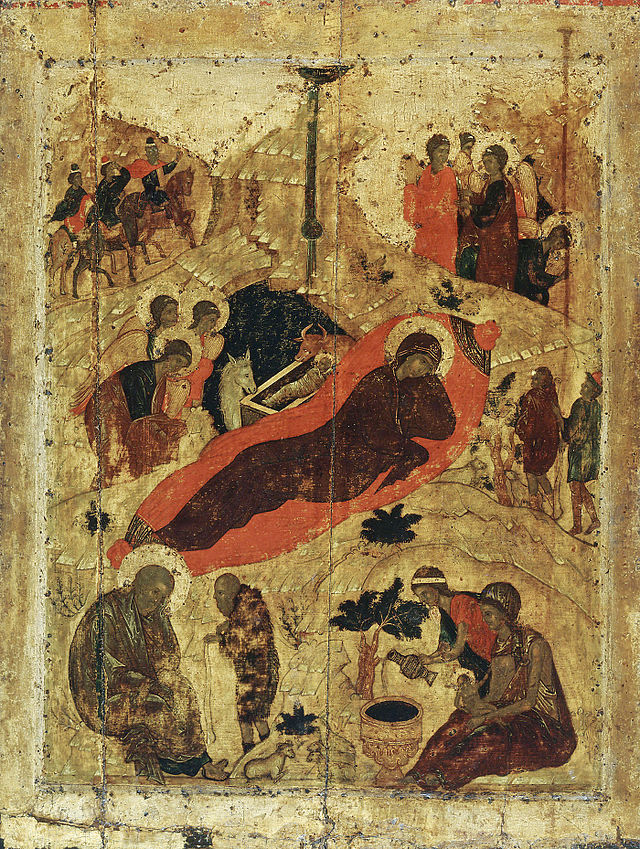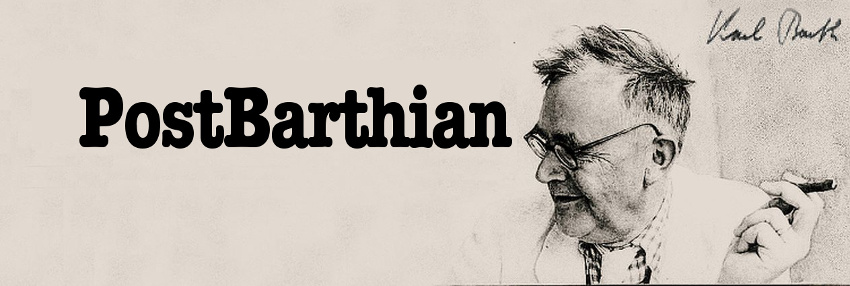
Nativity of the Lord, Icon by St. Andrei Rublev (1405),
Cathedral of the Annunciation,
Moscow Kremlin. (source: wikipedia)
Karl Barth believed in the Virgin Birth. Barth's theological nemesis Emil Brunner did not and most all of Barth's heirs chose to follow Emil Brunner's famous rejection of the Virgin Birth. Wolfhart Pannenberg sided with Brunner and rejected the historicity of the Virgin Birth (although he still affirmed the credal statement). Jürgen Moltmann also criticized the Virgin Birth and Rudolf Bultmann denied the historicity of almost everything in his demythologizing program (e.g. Jesus Christ and Mythology).
Barth affirmed the Virgin Birth but did not do so due to a mechanical view of inspiration that is unwilling to question or admit that there are problems with the two nativity stories contained in Matthew and Luke respectively. Barth affirmed the Virgin Birth because it communicated the truth that Jesus Christ is Emmanuel, who is God With Us.
The following famous quotation is from Karl Barth's Church Dogmatics IV.1 The Doctrine of Reconciliation (Study Edition 21) and explains Barth's argument for the Virgin Birth:
It would have to be imported into the passages in Mt 1:18-25 and Lk 1:26-38 and the credal statement about the Virgin birth in the creeds founded on these passages (cf. for what follows CD I/2 §15.2). And careful exegesis and dogmatics have always safeguarded them against this importation. In the creeds the assertion of the Virgin Birth is plainly enough characterized as a first statement about the One who was and is and will be the Son of God. It is not a statement about how He became this, a statement concerning the basis and condition of His Sonship. It is a description of the way in which the Son of God became man. The New Testament and the early Church never understood the relationship between the Holy Spirit and the Virgin Mary in mythical fashion as a Holy Marriage (ἱερὸς γάμος).
The Holy Spirit has never been regarded or described by any serious Christian theologian as the divine Father even of the man Jesus. In the exposition of this dogma—and thoroughly in the sense of its New Testament presuppositions—it has been frequently and energetically explained that it might have pleased God to let His Son become man in some quite different way than in the event of the miracle attested as the Virgin Birth. It did in fact please Him to let Him become man in this way, but this event is not the basis of the fact that the One who there became man was the Son of God. It is the sign which accompanies and indicates the mystery of the incarnation of the Son, marking it off as a mystery from all the beginnings of other human existences. It consists in a creative act of divine omnipotence, in which the will and work of man in the form of a human father is completely excluded from the basis and beginning of the human existence of the Son of God, being replaced by a divine act which is supremely unlike a human action which might arise in that connexion, and in that way characterized as an inconceivable act of grace.
"Conceived by the Holy Ghost" does not, therefore, mean "begotten by the Holy Ghost." It means that God Himself—acting directly in His own and not in human fashion—stands at the beginning of this human existence and is its direct author. It is He who gives to man in the person of Mary the capacity which man does not have of himself, which she does not have and which no man could give her. It is He who sanctifies and ordains her the human mother of His Son. It is He who makes His Son hers, and in that way shares with humanity in her person nothing less than His own existence. he gives to her what she could not procure for herself and no other creature could procure for her. This is the miracle of the Virgin Birth as it indicates the mystery of the incarnation, the first attestation of the divine Sonship of the man Jesus of Nazareth, comparable with the miracle of the empty tomb at His exodus from temporal existence. The question is pertinent whether His divine Sonship and the mystery of His incarnation are known in any real seriousness and depth when these attestations are of it are unrecognized or overlooked or denied or explained away. But in any case these attestations are based on His divine Sonship, not His divine Sonship on these attestations. They have a great deal to do with it poetically, but nothing at all ontically.
Karl Barth "Church Dogmatics: IV.1 The Doctrine of Reconciliation Study Edition 21" Ed. T. F. Torrance and G.W. Bromiley. Trans. G. W. Bromiley. London: T & T Clark, 2010. 200-01. Print. [207]
Related: CD IV.1, Church Dogmatics, Church Dogmatics IV.1, Emil Brunner, Karl Barth, Rudolf Bultmann, Virgin Birth, Wolfhart Pannenberg



May 14th, 2018 - 15:04
Brunner did not deny the virgin birth; rather he believed that Matthew and Luke were teaching a kind of parthenogenesis that sidelines the Incarnation. He inadvertently contradicts himself several times in that chapter by presenting several positions which jumble together. Nonetheless, if he were denying the virgin birth, he could not so vigorously deny adoptionism in the same sentence.
He states in his conclusion: “The great, unthinkable, unimaginable miracle of the Incarnation which the Apostles proclaim, is not that the Son of God was born as the son of a virgin, but that the Eternal Son of God, who from all eternity was in the bosom of the Father, uncreated, Himself proceeding from the Being of God Himself, became Man.”
In other words, the miracle of the “virgin birth” denotes a special creation of God in the womb of Mary, the blessed event of the Son of God [eternally begotten of the Father, begotten, not made] taking on flesh as the Incarnate Word. In this way God, as a man, has no father and Christ, as God, has no mother. The Incarnation of the Word as truly God and truly man is proclaimed; the doctrine of the eternal Sonship of Jesus Christ is preserved and adoptionism refuted.